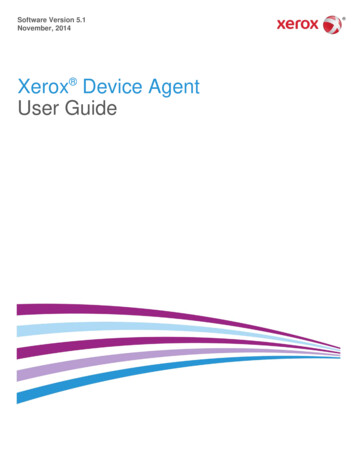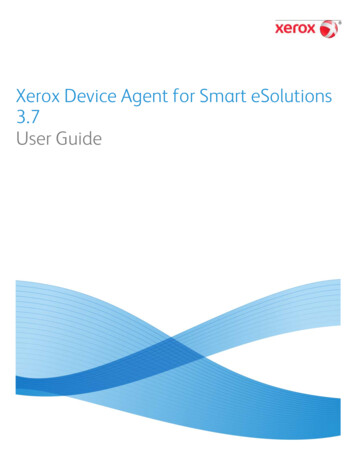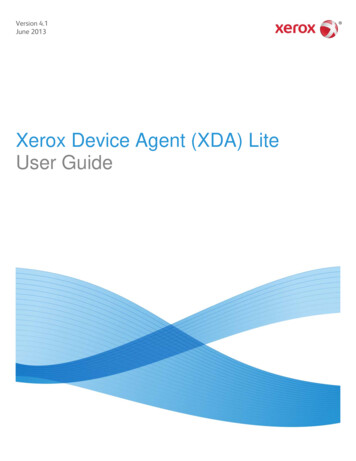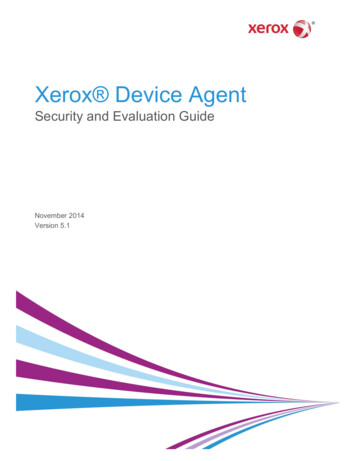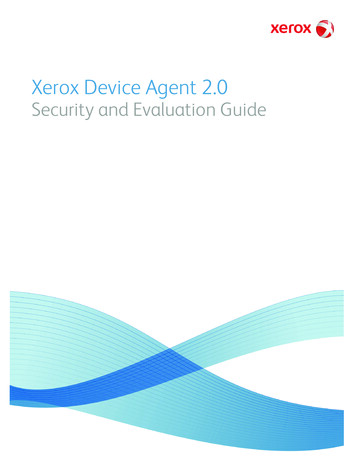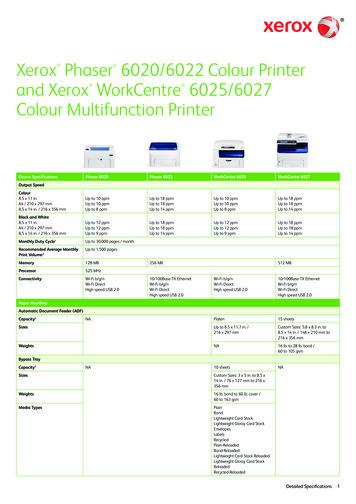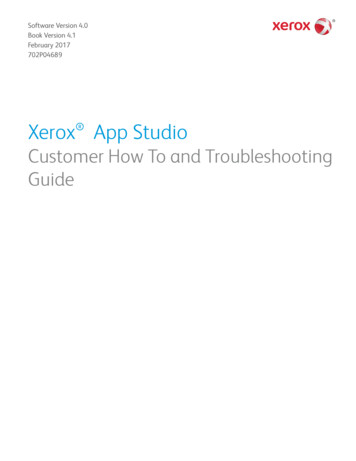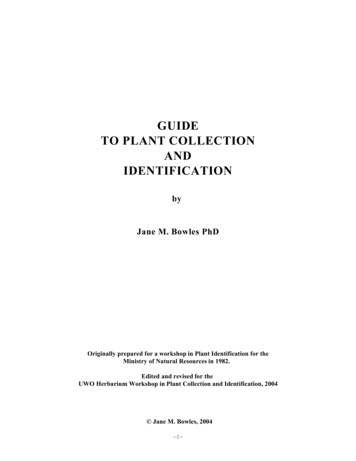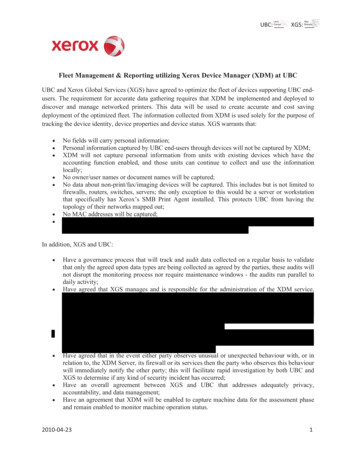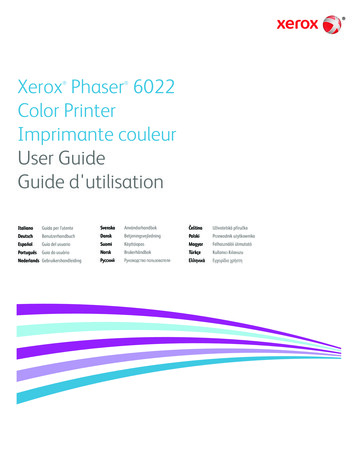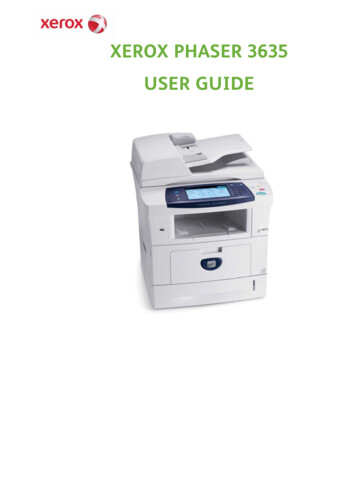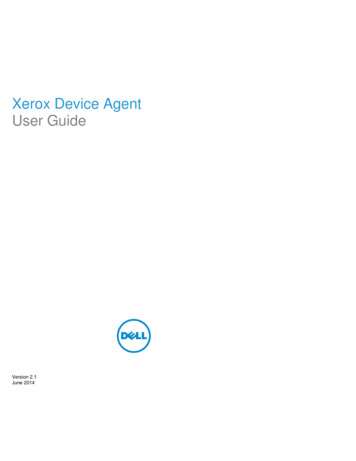
Transcription
Xerox Device AgentUser GuideVersion 2.1June 2014
Copyright 2014 Dell Inc. All rights reserved. This product is protected by U.S. andinternational copyright and intellectual property laws. Dell and the Dell logo aretrademarks of Dell Inc. in the United States and/or other jurisdictions. All other marks andnames mentioned herein may be trademarks of their respective companies. XEROX and XEROX and Design are trademarks of Xerox Corporation in the United States and/or other countries. Cisco is a registered trademark of Cisco Systems, Inc. and/or its affiliates in the United States and certain other countries. InstallShield is a trademark or registered trademark of Acresso Software Inc. SQL Server , Windows Server , and Microsoft .NET are either registered trademarks or trademarks of Microsoft Corporation in the United States and/or other countries. Linux is a registered trademark of Linus Torvalds. Macintosh is a registered trademark of Apple Inc. UNIX is aregistered trademark of The Open Group.Document version 2.1: June 2014
Table of ContentsIntroduction . 1Hardware and Software Requirements . 1Unsupported Configurations . 2Database Requirements . 2New Installation . 3Cancel Installation. 7Uninstall the Application . 8Auto Update . 9Cancel Installation during Auto Update . 9Configuration . 10Register the Account . 10Access the Configuration Wizard . 10Search for Printers . 25Access the User Interface . 29Resize the Application . 30System Tray and System Tray Context Menu . 30Popup Alerts. 31User Interface. 33Printers. 35Views . 36Dashboard. 36List . 39Common Features . 40Paging Controls . 40Filter . 40Find . 41List Features Only . 42Filter . 42Pin a Column. 42Group Printers . 43Sort Printer List . 43iii
ContentsContext Menu . 45Actions . 46Add a Printer by IP Address or DNS Name . 47Add Multiple Printers with an Address Range or Subnet . 48Add Direct Printer*. 50Delete Printer . 51Export the Printer List . 52Printer Properties . 53Status . 54Consumables . 56Information . 59Features . 61Transmitted Meters . 63Usage Summary . 64Usage Details . 65Synchronize . 66Views . 67Details . 67Settings . 69Search . 70Actions . 71Status Read . 73Actions . 74Local Alerts . 76Actions . 77Remote Alerts . 78Actions . 79Administrator . 79Actions . 80Languages . 81Actions . 82Updates . 83Actions . 84XPA . 85Actions . 85Log . 86Troubleshooting . 87iv*Direct-connected printers are not supported under Dell Toner Monitoring Service and Dell Print Page Service.
IntroductionXerox Device Agent (XDA) allows you to manage printing devices over the network. Theapplication finds printers, displays their statuses, automatically collects meters from the printers,submits the meter reads, and allows for remote management of the printers.Only network connected printers are supported by Dell Toner Monitoring Service andDell Print Page Service.Hardware and Software RequirementsBefore you can start using the client software, you must ensure that the following requirementsare met:Operating System: (32- and 64-bit) Windows XP Professional with Service Pack 3 Windows Server 2003 with Service Pack 2 Windows Server 2008 with Service Pack 1 and 2008 R2 with Service Pack 1 Windows Server 2012 Windows 7 Professional and Ultimate Windows 8 Windows Vista Service Pack 2 Professional and Ultimate Microsoft .NET framework 3.5 with Service Pack 1 installedMemory 512 MB RAM (1 GB Recommended) for Windows XP and Windows Server 2003 1 GB RAM (1.5 GB Recommended) for Windows Vista , Windows 7 Professional, Windows 8, Windows Server 2008, 2008 R2, 2012, and Windows 2003, 2008, 2008 r2Processor: 1.7 GHz processor or betterHard Disk: Minimum free space is approximately 380 MB, where 280 MB of that is for the Microsoft .NET 3.5 SP1 framework software, if not previously installed.Minimum Resolution: 1024x768Permissions: You must install the application software on the client computer using theadministrative account or an account with administrative privileges.Internet connection: RequiredNotes:1. We recommend that you update your host computers with the latest critical patches andservice releases from Microsoft Corporation.2. The Network Transmission Control Protocol/Internet Protocol (TCP/IP) must be loaded andoperational.1
Introduction3. Requires SNMP-enabled devices and the ability to route SNMP over the network. It is notrequired to enable SNMP on the computer where XDA will be installed or on any othernetwork computers. 4. You must install Microsoft .NET 3.5 SP1 before you install the application.5. The application should not be installed on a PC where other SNMP-based applications orother Xerox printer management tools are installed, since they may interfere with eachothers’ operation.Unsupported Configurations Installation of the application on a computer with another Xerox device managementapplication, such as Xerox Device Manager (XDM). Any version of Macintosh operating system, UNIX operating systems, Linux operating systems, Windows NT 4.0, Windows Media Center, and Windows 2000 This application has only been tested on VMware Lab Manager/workstation environment;other virtual environments are not supported. Direct-connected printers are not supported under Dell Toner Monitoring Service andDell Print Page Service.Database Requirements The application installs SQL Server 2005 Compact Edition (SQL CE) database engine anddatabase files that store printer data and application settings within the installation directory. Nodatabase licensing is necessary for the application.2
New InstallationOnce you receive your installation materials, you can install the software. In this section, you willlearn how to: Install the software Change the destination folder location of the applicationNote: Before installation, make sure that you disable the Sleep and Hibernation modes on anymachines that will be running the application in order to allow the application to collect andtransmit meter information.Note: You must be logged in as an administrator in order to install the application.1. Double-click the installation file. The Select Language screen opens. Note: If you do not have Microsoft .NET 3.5 SP1, the installer will display an error messagethat prompts you to install .NET 3.5 SP1 before you can continue with installation. You candownload the .NET 3.5 SP1 framework from the Microsoft Web site.Note: Click the Cancel button to cancel the installation process at any time.2. To continue the installation process, click Install.When the file download finishes, the License Agreement (EULA) displays.3
New Installation3. Click View Readme to review the ReadMe file.4. Click the appropriate radio button to either accept or reject the agreement.Note: If you are performing a manual update of the application and you have the currentversion of the application open, you will be prompted to accept the EULA. You will only seethis prompt if the EULA has changed since the last software release. To continue the installation, you must select the “I am authorized to accept, and accept,the terms of the license agreement” radio button, and click Next. To cancel the installation on this screen, click Cancel. To return to the previous screen, click Back.5. If you are upgrading from a previous version of the application or you had a previous versionof the application installed and you did not remove the database when uninstalling, you willsee the Database Options screen.4 Select the Use Existing Database option if you want to upgrade using the informationfrom your current database. Use this setting if the last installation was for the sameaccount and if it was configured as desired for the new installation. Select the Create New Database option if you want to create a new database. If youselect this option, the application will back up your current database, but you will need toconfigure the application and search for printers again in order to populate your newdatabase. Use this setting if the account used for the previous installation is unknown,different than the new account or configuration, or if you want to start with a cleaninstallation with default settings.
New Installation6. Once you have made your selection, click Install.7. The Installation Options screen opens, allowing you to change the default installation folderand enable or disable the desktop icon.Note: The Add icon to desktop check box is selected by default. Simply click the checkbox tounselect it if you do not want a desktop icon.5
New InstallationNote: If you are installing the application on an operating system in a language other than Englishwhere the "Program Files" directory name is localized, you will notice that the default installationpath displayed in the installer is indicated in English. The application, however, will install at thecorrect localized directory for your selected language. To accept the default location for the Destination folder, click Next (Recommended). To change the default location, click Change.The Browse for Folder dialog box opens.Navigate to and select the desired folder or create a new one. Click OK. The dialog box will close.Note: You cannot install your application in the root directory.You are now back at the Installation Options screen. Click Next.8. The Installing Xerox Device Agent screen opens, indicating the progress of the installation,followed by the Install Completed screen.6
New Installation To launch the application immediately, leave the check box saying “Launch Xerox DeviceAgent now” selected, and click Finish (Recommended). The Configuration Wizard willopen.Note: If other applications are running on your computer, you may experience a delay from thetime installation concludes and the Configuration Wizard begins. See the Registration section inConfiguration for more information. To launch the application later, de-select the check box and click Finish. See theRegistration section in Configuration for more information.Note: In order to run the application, you must complete the Configuration Wizard afterinstallation.Cancel InstallationYou can click Cancel on any of the screens during the installation process.1. When you click Cancel, the Cancel Install screen opens.7
New Installation2. Click Yes. The Install Failed! screen opens, indicating that the application remainsuninstalled. To install the application, you will need to run the installer setup file again.3. Click Finish.Uninstall the Application1. If you decide to uninstall the application, you will see the Uninstall Options screen. Select Do NOT remove the database if you would like to preserve your currentdatabase for use with your next installation of the application. Select Remove the database if you do not need to preserve your current settings for afuture installation. This setting will remove the active database and any future installationwill create a new database at the time of installation. If there were any databases backedup during the installation as part of the Database Options, they will not be removed.2. After you have made your selection, click Continue.8
Auto UpdateThe application supports automatic update. When a newer version of the application is released,it is loaded on the Auto Update server, which the application can connect to.The application will contact the Auto Update server at: Scheduled intervals that you set in the Updates section of the Settings area. Application startup if the schedule is in the past. Your request from the Updates section of the Settings area.The server will identify if there is a newer version available for download.See the Updates section for more information.1. If you set the application to prompt you when updates are available, or if you clicked to checkfor updates, the application will ask you to confirm whether or not you want to update theapplication. If you select No, the existing installation of the application will continue operating aspreviously. If you select Yes, the application will proceed automatically to: Download the new installer.Run the new installer (which will close the application if the application is open).Uninstall the older version and install the newer version.Run the new version of the application that was just installed.Cancel Installation during Auto UpdateIf you are updating the application, but you decide to cancel the installation process, you will haveto run the installation setup file again to complete the installation.Note: Depending on where you cancelled the update in the installation process, you may end upwith an unusable application.9
ConfigurationIn order to run the application, you must complete the Configuration Wizard after installationaccording to your site requirements. In the Configuration Wizard, you only need to enter aminimum set of requirements in order to successfully use the application.The Configuration Wizard is divided into three sections: Register the Account: enables communication between the application and Xerox ServicesManager (XSM). Search for Printers: allows you to find a printer or printers that you want the application tomanage and monitor. Completed: indicates that you have configured the application successfully.Register the AccountIn the Register the Account section, you can: Enter the administrator name, phone number, and e-mail address. Enter the application registration information. Modify the system name if applicable. Validate the default registration URL that is displayed, and modify if necessary. Configure proxy server and security settings for Internet connectivity. Modify synchronization settings if applicable.Access the Configuration WizardIf you chose to launch the application immediately after installation, the Install Completed screenwill close, and the Configuration Wizard starts automatically.Note: You will not be allowed to access the application if you have not completed theConfiguration Wizard. Each time you open the application, the Configuration Wizard will open andwill continue to pop up until you complete it successfully.If you did not launch the application immediately after installation, you can now access theConfiguration Wizard in on
Xerox Device Agent (XDA) allows you to manage printing devices over the network. The application finds printers, displays their statuses, automatically collects meters from t he printers, submits the meter reads, and allows for remote manage
